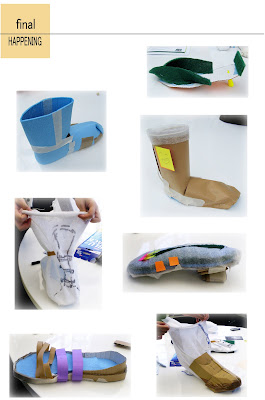PONG_
During the course of the observation project I realized that there is very popular and interesting business going on at Tilbury which is the business of recycling ‘ e’ waste. This led me to observing waste material more closely and finding new ways to reuse material. In Systems and Workshop I conducted a few experiments with glass bottles that I had picked up from the streets. I used wires and tape to bind them in different ways taking into consideration shapes, colours and functions, converting these discarded bottles into a piece of art or appealing objects.


---------- ----------- -----------
Broken but alive - Tilbury Dock
Broken : Tilburt town was once prosperous and the docks were a part of its history but now it is just a quiet, forgotten and broken down town.
Alive : A second glance at the town on a different occasion,painted a completely different picture.The quiet streets were filled children from the local schools and suddenly this grey city was filled with colour.
What I took back from Tilbury was the coexistance of destruction and life.
This has been the inspiration for my journey through the process module .
--------- -------- ---------
MINSUNG_
Our impression of Tilbury town with its recycling e-waste plants and tall walls was that the people in the town seemed to watch us as if they were hiding something from its visitors.
During the systems section we tried to express these hiding space, using various materials such as bottles, cardboard, masking tape or zipper etc. Strips of various materials seem to express a variety of feeling. Each separated strip sometimes gave a feeling of elegance when hung from the ceiling. When this was duplicated and multiplied the overlapping layers of strips also brought about a sense of mystery, as well as curiosity. I took inspiration from this experiment and applied it to various other materials like metal and paper.
The effect was really interesting and I would like to see the possibility of applying this technique to various product of daily use
 .
.
---------- ---------- ----------
SHRIYA_
During the systems and workshop modules I explored with various materials and developed simple techniques to merge materials together. Most of my exploration revolved around using discarded materials like plastic paper, off cuts of Veneer, old cycle chains and used tape rolls etc.
The following are a few observations made on the manner in which different materials reacted to each other.
· Interesting forms, negative and positive spaces were created.
· The change in the property of a material once it had undergone a machining process.
· The intermingling of properties of contrasting materials when used together.
· The method of joining two materials can change the perceived properties of the materials.
Mini Brief
Using the original intended properties of a machine part to create another object of use.

For example a cycle chain has the following properties
· Strong
· Flexible
· Designed to grip
Can the engineering that has been invested in developing this machine part be put to use to create other simple everyday objects that use its properties after the machine part has completed its life cycle?
(Please see previous entries for more examples)
“Recycled engineering”
---------- ---------- ----------
JUDY_
Following my experimentations with plasters and moulds during the past weeks I am intending to look further into the subjects of "impact" and "loneliness":
_one:
Explore aspects of isolations and interactions within emotions, materials and human relations etc.
_two:
Explore the contrasting textures and shapes of soft/hard materials by adding a new dimension time using processes of drying/freezing, breaking etc.
---------- ---------- ---------
JACKIE_
In the System Project, I found myself really interested in mixed glass bottles.We did a lot of experiments on these materials, including breaking the glass bottles.
We stuck the pieces of glass on to masking tapes and hung from the ceiling as an installation. The fragments shapes and sizes are irregular but this made them more interesting when they were suspended. We also discovered that when light went through glass bottles at different times of the day the quality of coloure changed casting interesting forms on the floor


---------- ---------- ----------
LOTING_
I explored with a variety of materials, such as glass, tape, clay, paper...etc. and found inspiration from working with paper.
My interest was in transformation and creating 3D shapes with a variety of different materials. Something as simple as paper, which is a plane form originally, can become a complicated 3D form by folding, cutting, twisting, and pulling. I also realised that the process of creativity is similar to that of sculpture.
During my explorations, I learned about the different character and limitation of different materials. This will help me in the future to use materials in different ways. In addition, I also found two interesting points relate to space design. One is the shape of curves and the other is regular patterns.
I would like to carry on with my study of free forms using different materials and then apply this to space design.


---------- ----------- -----------
LIANNA_
My mini brief to develop in Ideation Lab, focuses on the concept of play and human interaction with objects and shapes.
By creating objects/spaces/outlines/forms and seeing how people physically respond, by using, exploring and creating things with these pieces. Also with the concept of puzzles I have been creating these pieces that can be put together to create a variety of forms, I would like to explore and record the different outcomes that would be created by different people playing with these pieces, how one thing could be many, for example one 'form' could be a chair and a top and or bag?



 Collaborate with Innoversity
Collaborate with Innoversity 














































